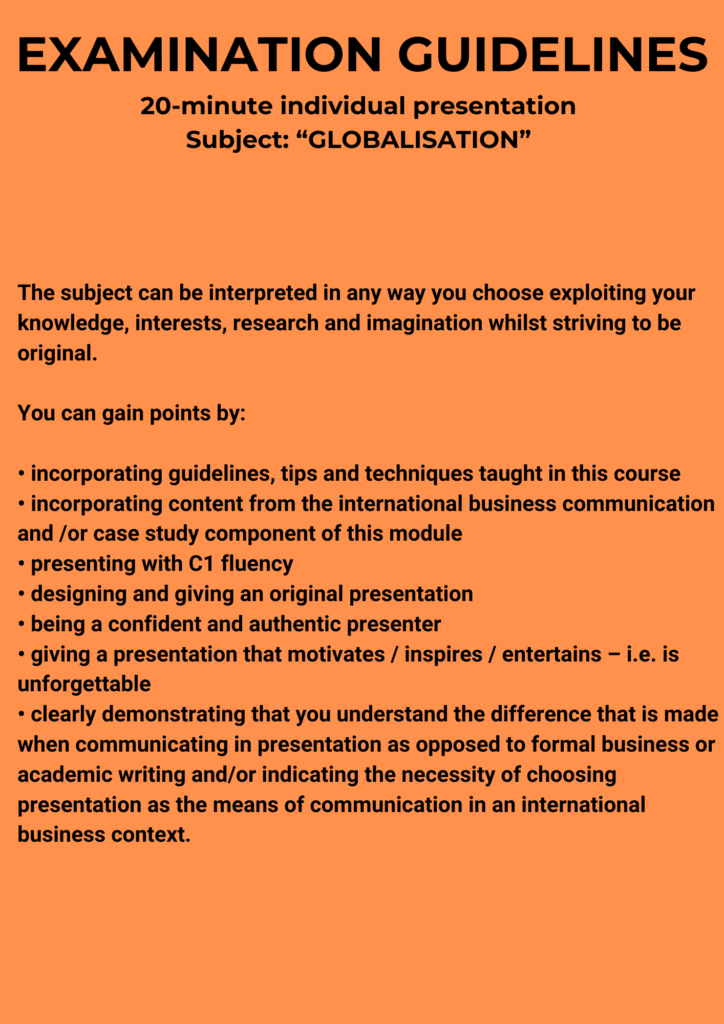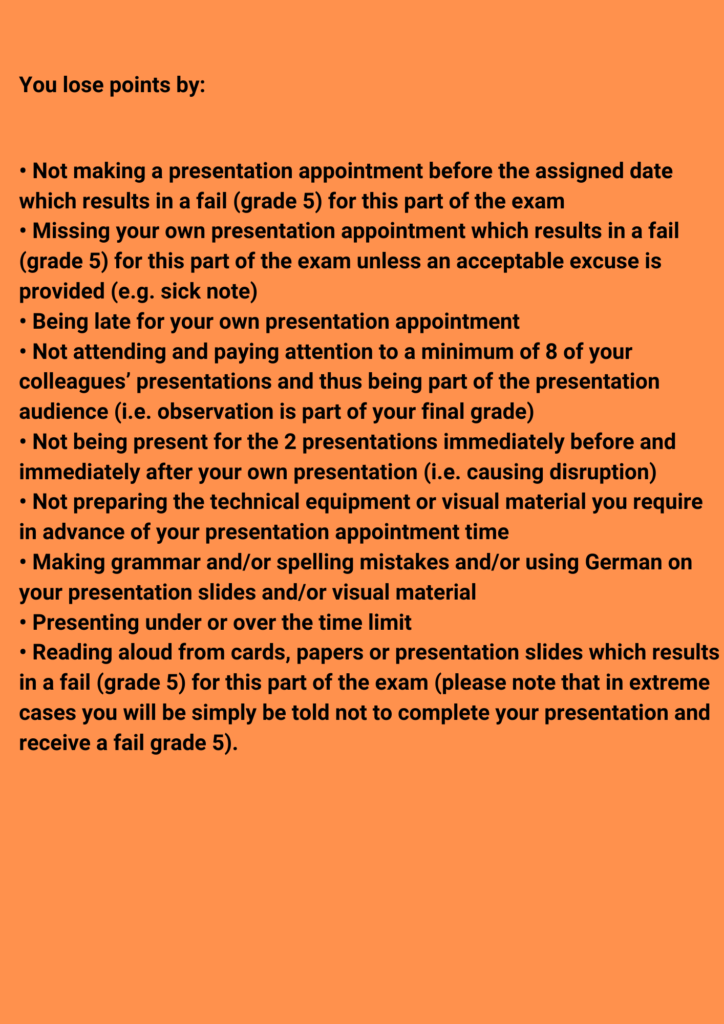If you tell students exactly what is expected and the precise criteria by which they are being examined, then they will strive to produce presentations that meet your expectations.
Here are examples of guidelines that I found helped students to find orientation and direction in their planning. These guidelines were published on the (German) university website and on the course moodle. In addition, every student received a paper copy.
EXAM GUIDELINES: EXAMPLE 1
The students attending this exam were studying their 4th semester of Business English and were at C1 level. By the time of the exam, students had had the opportunity of attending 50-60 hours of intensive presentations’ training and teaching in groups of around 15 students. The expectations and the standards for the exam were high.


Let’s expand on some points:
The subject can be interpreted in any way you choose exploiting your knowledge, interests, research and imagination whilst striving to be original
The subject chosen for this exam was deliberately wide. This enabled students to research and produce work in an area that particularly interested them and sparked their enthusiasm. In turn, this enabled most students to have a positive experience in giving their presentation. Positive experience is an essential building block in developing as a presenter. Moreover, the range of subjects chosen by students was consistently interesting with enough variety to keep the examiners engaged. The subject was used over a number of years and every year threw up new areas of interest and trends so that presentation content rarely became tired or boring.
incorporating guidelines, tips and techniques taught in this course
incorporating content from the international business communication and /or case study component of this module
This, of course, meant that students were not expected to incorporate everything in a 20-minute presentation. This would be a disaster and during the course the students were encouraged to “pick and mix” materials and techniques according to their own preferences and the nature of the presentation. This was also expected in the final exam presentation.
presenting with C1 fluency
The emphasis in this exam was on fluency rather than 100% accuracy – and I would defy a native speaker to be 100% accurate over 20 minutes. The emphasis was rather on the ability to communicate and use the lessons learnt on presentations. So, if somebody used an adjective rather than an adverb for example, this was not listed as an “error” as long as meaning was clear and communicated. On the other hand, an inability to express and put across meaning, for instance, when talking about the past and future would have been penalised.
clearly demonstrating that you understand the difference that is made when communicating in presentation as opposed to formal business or academic writing and/or indicating the necessity of choosing presentation as the means of communication in an international business context
This was a huge part of the teaching on this course and the emphasis was on designing a presentation and presentation message that fit the timeframe and demonstrated why presentation was being used as the communication tool.
reading aloud from cards, papers or presentation slides which results in a fail for this part of the exam – if you do so, you will be told not to complete your presentation and receive a fail
These aspects were emphasised in the teaching and practising of presentations and the students soon learnt that their future examiners noticed when presenters were reading or had learnt by heart. This has a lot to do with connection with the audience and material – poor eye contact and a robotic unnatural style are generally giveaways.
Once we put this guideline on paper in black and white, students simply stopped reading from notes and slides. It was that easy and everyone benefited. The students became much better presenters and the teachers/examiners had a much more rewarding teaching experience.
not making a presentation appointment before the assigned deadline which results in a fail for this part of the exam
missing your own presentation appointment which results in a fail for this part of the exam unless an acceptable excuse is provided
being late for your own presentation appointment
not preparing the technical equipment or visual material you require in advance of your presentation appointment time
Again, these guidelines just made life easier. Students were made responsible for their own organisation and administration and once they had this information in writing, they tended to follow the guidelines. Overall, this is not bad practice and good training for future working life. Of course, some flexibility is necessary at times. I can remember once holding examinations during a heavy snowfall on a Saturday. Everything ran late and had to be juggled around on the day.
making grammar and/or spelling mistakes and/or using German on your presentation slides and/or visual material
This is generally unforgiveable and gives a bad impression of the presenter. This was again emphasised in teaching and practice and was part of teaching the importance of design of visual material in presentation.
presenting under or over the time limit
Conscientious students, those who really wanted to become good presenters and get a good grade, practised and refined their presentations so that they would frequently finish at 20 minutes. Again, some flexibility is required. Candidates get nervous and sometimes present faster in the exam environment than they have done in their practice for instance. So, presenting from around 18 to 22 minutes was generally allowed. However, a student who presented for 10 minutes or hadn’t come to the last point after 35 minutes was penalised as s/he had clearly not put in the work to produce the presentation that was required.
not attending and paying attention to a minimum of 8 of your colleagues’ presentations and thus being part of the presentation audience
not being present for the 2 presentations immediately before and immediately after your own presentation
Not every examiner will want to do this but we arranged “presentation days” where students observed their peers. There were several reasons for this. Firstly, the importance of observation in developing presentation skills was stressed throughout the course. Students were accustomed to and comfortable with observation. Secondly, presenting to a panel of examiners is generally not a true presentation experience. Presenting to a panel could happen in a job assessment but the aim was to give the students as real and positive experience as was possible in the circumstances. We got permission from the university so that everyone could bring in food and drink and create a comfortable atmosphere. Some groups were very supportive and many students came to many more than 8 presentations.
Also, I can fully accept that a presenter may not want to watch the presentation directly before or after his/her own presentation. Frankly, I would not want to do this myself and would prefer to be in my own space during these times. This guideline was treated flexibly. If students indicated they were in the building and would be there for their own appointments, we tended to go along with their preferences and wishes.
EXAM GUIDELINES: EXAMPLE 2
Here are the guidelines for a different exam. Students on this course specialised in marketing communications and were examined on giving a pitch presentation as pitch presentation is typical practice in the marketing communications industry.
The language level that was examined was B2. Some students had a higher language level and/or considerable work experience but some students were at a B1 level. It was possible for students at a B1 level to pass this part of the exam if they used their abilities to communicate effectively. Teaching was in groups of around 20 students and took place over 2 semesters (1 year). Presentation teaching and practice was about 50% of the course as this reflected the final grade allocation.
The subject matter was open again to provide variety and for students to use their creativity. However, pitch presentation and the format and skills of pitch presentation were taught and practised in the course so that students were penalised when they did not deliver a pitch.



Thanks for these exam guidelines – very useful indeed!
You’re welcome (:
Erica